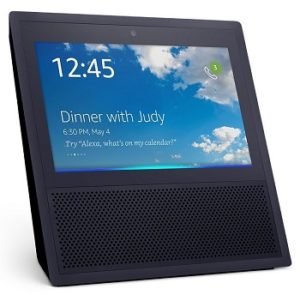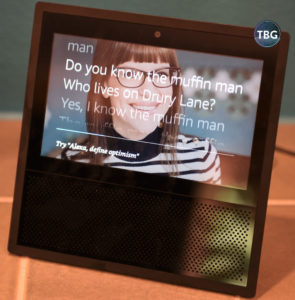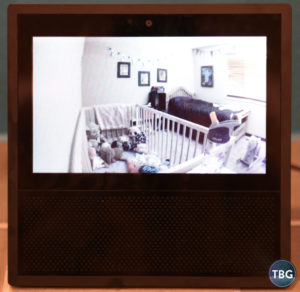Amazon Echo Show Review
Pros
Cons
Rating

Introduction
When Amazon first announced the Echo Show, we knew we had to get our hands on one for review. We pre-ordered a two-pack that very day, and received our Shows on June 28, the day they were released. We’ve been using them extensively ever since, and over more than 30 days of testing, we’ve come to some pretty firm conclusions about the device. We think you’ll find a lot more insights into what the Show is really all about in this review than what you saw in launch-day reviews from sites that received media samples. For better and for worse, a review written based on a few days of testing most definitely can not sum up the entirety of the Echo Show experience.
We purchased our Echo Show samples at retail from Amazon. They currently retail for $230 each or $360 for two. Read on to find out whether this is the Smart Home revolution we’ve been looking for!
Critical Update: We have permanently lowered the score on this product from 4 stars to 3.5 stars due to the removal of Google’s YouTube app from the device for a second (and likely final) time. Google is pulling all support for its video services on Amazon devices due to an ongoing dispute between the two companies over Amazon’s refusal to sell Google’s products on the Amazon storefront. This is a clear case of the consumer losing when companies battle it out.
Description and Features
The Echo Show is fairly substantial, at 7.4” wide, 7.4” tall, and 3.5” deep. It weighs just over 2.5lb., or about as much as many high-end laptops. That’s a bit surprising given the relatively-small 7″ touchscreen and lack of a battery, but it probably comes down to the dual 2″ speakers, which provide sound capabilities that you won’t find in any laptop. Also on board is a 5 megapixel camera and dual-band Wi-Fi that supports 802.11 a/b/g/n (2.4 and 5 GHz) networks. We’re a bit shocked that Amazon hasn’t included 802.11ac support, but luckily the bandwidth provided by the 802.11n 5GHz band will probably be sufficient for any possible usage scenario. Like the Echo Dot, but unlike the original Echo, the Show includes Bluetooth A2DP support for audio streaming from Echo Show to your Bluetooth speaker. In an odd twist, it also supports streaming from your mobile device to Echo Show, which we presume you’d do if you called up something on your phone and wanted the Show’s better speakers, but ideally you’d call up the content on the Show itself. We’ll cover what Show is able to display natively a bit later in this review. Powering this little powerhouse is the Intel Atom x5-Z8350 processor, which in case you haven’t kept up with Intel’s Atom line, is among the most popular CPUs in current low-cost 2-in-1 laptops, which often go for about $250. It’s really a fairly robust solution, and clearly “shows” that the Show is meant to do everything a tablet can and more.

To set up the Show, you’ll need to use the Alexa App, which is available for Fire OS, Android, and iOS devices. Frankly, this is a serious mis-step by Amazon. Given that the Show is essentially a stand-alone tablet, why does it need a smartphone to set it up? We’ve found that the Alexa App has only grown harder to use as the Echo family has added features, and the worst part of all is that it’s nearly impossible to understand how and why Amazon implemented the contacts feature in the App. It does not appear to allow actually adding contacts except at initial startup. After that, you have to count on Amazon to push new contacts to you as they purchase Echo devices or download the Alexa App. This is a huge oversight, and furthermore, adding contacts should be possible from the Show’s screen, because it’s smarter and more powerful than any smartphone, so why rely on a third-party device to set up all of its key features?
And it has a lot of key features. In addition to everything that the screen-less Echoes can do, the Show has the ability to show song lyrics, make video calls, play TV shows and movies, and display your cloud-based photo albums. It really does promise to replace just about every gadget you have in your home, and in our opinion, the Show is the closest thing we’ve seen to offering the future presented in the classic 1993 AT&T “You Will” TV spots, which all futurists owe themselves the opportunity to view again (or for the first time!). This was before the age of the Internet, e-mail, cell phones, or GPS, and yet AT&T predicted it all. The most touching promise of all was that you could “tuck your baby in from a phone booth” using video conferencing. Yes, Apple’s Facetime has allowed you to do that for a few years now, but comparing a Smartphone and a Smart Home device is missing the bigger picture that these are two different types of devices, and they both have a place in our lives. In fact, we think the Show could very well be the next must-have device, now that billions of people all over the world have smartphones.
All right, let’s move on to how the Echo Show performs in real-world use. Does it really add to the standard Echo experience, or does it just make it more complicated? Read on to find out!
Performance

We tested the Show in an extensive Smart Home ecosystem to truly put it to the test. Here’s what our setup consisted of:
- one Amazon Echo
- three Amazon Echo Dots
- one Amazon Tap
- one Wink Hub 2
- six Lutron Caseta dimmers
- one GE Link BR30 bulb
- five Cree Connected bulbs
- one Commercial Electric smart downlight
- one Leviton Decora Z-Wave dimmer
- one Leviton Decora Z-Wave switch
- one Leviton plug-in dimmer module
- one Leviton plug-in appliance module
- one Logitech Circle Cam
- one Ring Stick Up Cam
- One MyFox home security system with camera
- one Carrier Cor thermostat
- one Schlage Connect smart lock
So first things first: Amazon clearly hasn’t improved its voice recognition, and this is going to be a huge problem going forward. When the Echo first arrived in 2014 and people were just using it to look up sports scores and the weather, Amazon’s Alexa voice service was sufficient. Now that Amazon would like you to do everything on the Echo (and we tried to do practically everything on it), Alexa is sorely lacking. In fact, we’ve found that Google Home, while inferior in terms of features and third-party integration, is dramatically better at voice recognition, so we know it’s possible. Making matters worse is the fact that the Echo Show’s “far field” microphone clearly isn’t tuned to work quite as far afield as the microphones on every other Echo device. We tested the Echo Show in a house-full of Echo devices (six to be exact, including one Echo, one Tap, and three Dots). During our month’s worth of testing, voice commands were picked up and acted upon by Echo devices in other rooms rather than the Echo Show we were standing in front of about 1/3 of the time.
Yes, this is a very big problem, and for serious Echo enthusiasts (collectors?), it’s going to be a huge letdown. We suspect that Amazon really didn’t test out its “beta” voice triangulation feature sufficiently on the Show. This was rolled out in a silent firmware update in February, and was supposed to allow various Echo devices to “know” when another closer device was responding. Well, it sort of works, in the sense that 1/3 of the time, the Echo Dot in the living room responds and the Echo Show we’re two feet away from doesn’t, but we don’t think this was quite how Amazon intended it to function. If you’ve read other reviews stating that the Show’s voice recognition works great, we can assure you that the testers didn’t have any other Echo devices in their testing environment. Furthermore, Amazon has yet to release an Echo device with voice recognition truly up to the task of delivering all that the Echo promises.
OK, so we’re down on the Show, but let’s add a little positivity to this discussion. The Show has the potential to replace nearly every device in your home! Want a digital photo frame that won’t break down after a few months? You got it. Need a bedside combination sound machine and alarm clock? No problem. Looking for a voice-activated intercom for your entire home? Echo can do it. Need a device that offers true, reliable video calling between you and your loved ones using any smartphone? Amazon’s bringing it to you. Need a smart kitchen assistant that can display recipes and even how-to videos? It’s in the bag. Want a desktop device to monitor CNN, browse YouTube, or catch your favorite Amazon Prime TV shows or movies? Go ahead. Launch or dock your home robots, like the iRobot Roomba vacuum? Just ask! And yes, you can even listen to music on it, complete with lyrics (some of the time), and of course it will still work as a voice control for all your Smart Home devices, provided you have a Smart Home hub (we tested it with the Wink Hub 2).

Just a few details on some of the most-hyped features of the Show:
- Voice calling between two Shows or between the Show and a smartphone is very effective, but has two drawbacks: contacts support is sorely lacking in the Alexa app (and contacts can’t be added via the Show), and the visual feed is in need of some tweaking. On Show-to-phone calls, you’re locked into an awkward incompatible view (horizontal on the Show, vertical on a phone). The screenshot from our Samsung Galaxy S7 demonstrates the problem. A simple (and obvious) solution to this would be for Amazon to enable screen and camera rotation in the Alexa app (although all front-mounted smartphone cameras will then be off-center). Furthermore, the camera on the Show points up along with the rest of the Show’s front fascia, meaning you get a great view of the ceiling in most conversations. Clearly, Amazon designed and tested this with adults holding conversations while standing up, but that’s not of much use if you want to have little Peter or Susie talk to grandma and grandpa!
- Yes, there is lyric support for many but not all songs. We found that it worked with Katy Perry, Coldplay, Madonna, and Lisa Loeb’s recent children’s album, for example, but not Bruce Springsteen or lesser-known kids’ music. Interestingly, we remember back in the early days of the Internet, before anyone had ever heard of MP3s, the music industry fought vigilantly against the sharing of song lyrics on the World Wide Web. We suspect the higher-ups at the RIAA are still fighting the “good fight” here, and Amazon just isn’t willing to pay up. You can see what the lyric feed looks like on the previous page.
- Yes, you can actually view certain video cam feeds directly on the Show, allowing you to potentially replace that over-priced baby monitor you bought when the little one was born! You can see such a feed from our Logitech Circle Cam at the top of this page.
And here’s the thing: the Show is only going to get better. Amazon keeps adding services to the Echo family, and these have the potential to increase exponentially now that a screen has been added. As with any Echo device, we could turn on or off all of our lights, lock our door using our Schlage Connect Smart Lock, and enable our MyFox home security system using only our voice. But as manufacturers start to think more broadly about using the Show’s screen, we’ll see even more integration.
Alas, Amazon is relying very heavily on third parties here, and that does not come without serious risks. The MyFox home security system we tested, for example, has been discontinued. Ring’s integration with Alexa is incomplete at best (most of its products don’t work with the Show, including our Ring StickUpCam, despite Amazon’s heavy promotion of Ring integration). Our Carrier Cor thermostat never adopted the Alexa voice service. And most worrisome of all, Wink has just been sold to rapper Will.i.am, in a move that many view as a desperation bailout. We’ve loved Wink ever since the first Wink Hub was released, thanks to its low price and amazing support, but we always wondered how it could make a dime. In the end, it probably never did. We’ve experienced the pain and suffering when a cloud service we’ve invested in heavily goes off line (thanks a lot, TCP Connected and Belkin Wemo), and we fully expect that more and more of the venture-capital-backed startups churning out the latest Smart Home devices are going to go belly up in the years to come. Amazon has the market penetration and the deep pockets to make a truly-robust Smart Home ecosystem a realty. Our only question is what is Jeff Bezos waiting for?
Conclusion
While we’re clearly a bit disappointed at this first-generation Echo Show, there’s simply no doubt that Amazon’s domination of the Smart Home voice assistant arena will continue, and the Echo Show is a glimpse of what the future of the Smart Home will look like. It absolutely takes voice recognition to the next level, as the visual feedback, and indeed the visual content, makes this so much more of a personal AI than any faceless obelisk could ever be. You feel like you’re talking to someone (or at least something), rather than into thin air, and the fact that you see responses to your inquiries makes the interaction feel much more complete. Add to that the fact that you can really make video calls, watch movies, view photos, and see your security cameras on the device, and you’ll realize that it can replace a whole host of devices.
There are just four major changes that need to occur before we can recommend that every consumer with the means snap up a Show: voice recognition simply must improve dramatically, the Show must add a built-in battery for short-term wireless use (which should be simple given its tablet-sized screen and processor), the camera must add some adjustability, either via a gimbal or a foot on the back of the Show, and Amazon should end its reliance on third-party hubs like SmartThings, Wink, and Philips and integrate Z-Wave and Zigbee radios into the Show. With these four improvements, the Show would not only be perfect, it would be essential, and would become the must-have center of every Smart Home.
The Show is available for $229.99 shipped from Amazon, as of our publication date.
To learn more about setting up your own Smart Home, see our Smart Home Buyer’s Guide for our most recent product recommendations!

